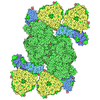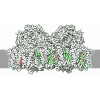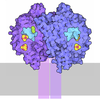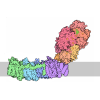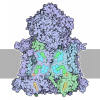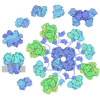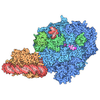+ Open data
Open data
- Basic information
Basic information
| Entry | Database: PDB / ID: 8zeh | ||||||
|---|---|---|---|---|---|---|---|
| Title | PSI-FCPI-L in Thalassiosira pseudonana | ||||||
 Components Components |
| ||||||
 Keywords Keywords | PHOTOSYNTHESIS / photosystem I | ||||||
| Function / homology |  Function and homology information Function and homology informationlight-harvesting complex / photosynthesis, light harvesting in photosystem I / photosynthesis, light harvesting / photosystem I reaction center / photosystem I / photosynthetic electron transport in photosystem I / photosystem I / chlorophyll binding / chloroplast thylakoid membrane / response to light stimulus ...light-harvesting complex / photosynthesis, light harvesting in photosystem I / photosynthesis, light harvesting / photosystem I reaction center / photosystem I / photosynthetic electron transport in photosystem I / photosystem I / chlorophyll binding / chloroplast thylakoid membrane / response to light stimulus / photosynthesis / chloroplast / 4 iron, 4 sulfur cluster binding / electron transfer activity / oxidoreductase activity / magnesium ion binding / metal ion binding / membrane Similarity search - Function | ||||||
| Biological species |  Thalassiosira pseudonana CCMP1335 (Diatom) Thalassiosira pseudonana CCMP1335 (Diatom) | ||||||
| Method | ELECTRON MICROSCOPY / single particle reconstruction / cryo EM / Resolution: 2.78 Å | ||||||
 Authors Authors | Feng, Y. / Li, Z. / Wang, W. / Shen, J.R. | ||||||
| Funding support |  China, 1items China, 1items
| ||||||
 Citation Citation |  Journal: J Integr Plant Biol / Year: 2025 Journal: J Integr Plant Biol / Year: 2025Title: Structures of PSI-FCPI from Thalassiosira pseudonana grown under high light provide evidence for convergent evolution and light-adaptive strategies in diatom FCPIs. Authors: Yue Feng / Zhenhua Li / Yang Yang / Lili Shen / Xiaoyi Li / Xueyang Liu / Xiaofei Zhang / Jinyang Zhang / Fei Ren / Yuan Wang / Cheng Liu / Guangye Han / Xuchu Wang / Tingyun Kuang / Jian- ...Authors: Yue Feng / Zhenhua Li / Yang Yang / Lili Shen / Xiaoyi Li / Xueyang Liu / Xiaofei Zhang / Jinyang Zhang / Fei Ren / Yuan Wang / Cheng Liu / Guangye Han / Xuchu Wang / Tingyun Kuang / Jian-Ren Shen / Wenda Wang /   Abstract: Diatoms rely on fucoxanthin chlorophyll a/c-binding proteins (FCPs) for light harvesting and energy quenching under marine environments. Here we report two cryo-electron microscopic structures of ...Diatoms rely on fucoxanthin chlorophyll a/c-binding proteins (FCPs) for light harvesting and energy quenching under marine environments. Here we report two cryo-electron microscopic structures of photosystem I (PSI) with either 13 or five fucoxanthin chlorophyll a/c-binding protein Is (FCPIs) at 2.78 and 3.20 Å resolutions from Thalassiosira pseudonana grown under high light (HL) conditions. Among them, five FCPIs are stably associated with the PSI core, these include Lhcr3, RedCAP, Lhcq8, Lhcf10, and FCP3. The eight additional Lhcr-type FCPIs are loosely associated with the PSI core and detached under the present purification conditions. The pigments of this centric diatom showed a higher proportion of chlorophylls a, diadinoxanthins, and diatoxanthins; some of the chlorophyll as and diadinoxanthins occupy the locations of fucoxanthins found in the huge PSI-FCPI from another centric diatom Chaetoceros gracilis grown under low-light conditions. These additional chlorophyll as may form more energy transfer pathways and additional diadinoxanthins may form more energy dissipation sites relying on the diadinoxanthin-diatoxanthin cycle. These results reveal the assembly mechanism of FCPIs and corresponding light-adaptive strategies of T. pseudonana PSI-FCPI, as well as the convergent evolution of the diatom PSI-FCPI structures. | ||||||
| History |
|
- Structure visualization
Structure visualization
| Structure viewer | Molecule:  Molmil Molmil Jmol/JSmol Jmol/JSmol |
|---|
- Downloads & links
Downloads & links
- Download
Download
| PDBx/mmCIF format |  8zeh.cif.gz 8zeh.cif.gz | 1.2 MB | Display |  PDBx/mmCIF format PDBx/mmCIF format |
|---|---|---|---|---|
| PDB format |  pdb8zeh.ent.gz pdb8zeh.ent.gz | 1.1 MB | Display |  PDB format PDB format |
| PDBx/mmJSON format |  8zeh.json.gz 8zeh.json.gz | Tree view |  PDBx/mmJSON format PDBx/mmJSON format | |
| Others |  Other downloads Other downloads |
-Validation report
| Arichive directory |  https://data.pdbj.org/pub/pdb/validation_reports/ze/8zeh https://data.pdbj.org/pub/pdb/validation_reports/ze/8zeh ftp://data.pdbj.org/pub/pdb/validation_reports/ze/8zeh ftp://data.pdbj.org/pub/pdb/validation_reports/ze/8zeh | HTTPS FTP |
|---|
-Related structure data
| Related structure data |  60032MC  8zetC M: map data used to model this data C: citing same article ( |
|---|---|
| Similar structure data | Similarity search - Function & homology  F&H Search F&H Search |
- Links
Links
- Assembly
Assembly
| Deposited unit | 
|
|---|---|
| 1 |
|
- Components
Components
-Protein , 7 types, 7 molecules ABEFrDc
| #1: Protein | Mass: 16623.979 Da / Num. of mol.: 1 / Source method: isolated from a natural source Source: (natural)  Thalassiosira pseudonana CCMP1335 (Diatom) Thalassiosira pseudonana CCMP1335 (Diatom) |
|---|---|
| #2: Protein | Mass: 18249.709 Da / Num. of mol.: 1 / Source method: isolated from a natural source Source: (natural)  Thalassiosira pseudonana CCMP1335 (Diatom) Thalassiosira pseudonana CCMP1335 (Diatom)References: UniProt: B8C770 |
| #4: Protein | Mass: 20184.035 Da / Num. of mol.: 1 / Source method: isolated from a natural source Source: (natural)  Thalassiosira pseudonana CCMP1335 (Diatom) Thalassiosira pseudonana CCMP1335 (Diatom) |
| #5: Protein | Mass: 18561.406 Da / Num. of mol.: 1 / Source method: isolated from a natural source Source: (natural)  Thalassiosira pseudonana CCMP1335 (Diatom) Thalassiosira pseudonana CCMP1335 (Diatom) |
| #22: Protein | Mass: 9740.316 Da / Num. of mol.: 1 / Source method: isolated from a natural source Source: (natural)  Thalassiosira pseudonana CCMP1335 (Diatom) Thalassiosira pseudonana CCMP1335 (Diatom)References: UniProt: B8BRQ8 |
| #23: Protein | Mass: 18091.611 Da / Num. of mol.: 1 / Source method: isolated from a natural source Source: (natural)  Thalassiosira pseudonana CCMP1335 (Diatom) Thalassiosira pseudonana CCMP1335 (Diatom)References: UniProt: B8CEQ3 |
| #25: Protein | Mass: 8675.973 Da / Num. of mol.: 1 / Source method: isolated from a natural source Source: (natural)  Thalassiosira pseudonana CCMP1335 (Diatom) Thalassiosira pseudonana CCMP1335 (Diatom)References: UniProt: A0T0W4, photosystem I |
-Fucoxanthin chl a/c light-harvesting ... , 5 types, 5 molecules CGHIJ
| #3: Protein | Mass: 18537.982 Da / Num. of mol.: 1 / Source method: isolated from a natural source Source: (natural)  Thalassiosira pseudonana CCMP1335 (Diatom) Thalassiosira pseudonana CCMP1335 (Diatom)References: UniProt: B5YM25 |
|---|---|
| #6: Protein | Mass: 18926.678 Da / Num. of mol.: 1 / Source method: isolated from a natural source Source: (natural)  Thalassiosira pseudonana CCMP1335 (Diatom) Thalassiosira pseudonana CCMP1335 (Diatom)References: UniProt: B8C8Q0 |
| #7: Protein | Mass: 18522.117 Da / Num. of mol.: 1 / Source method: isolated from a natural source Source: (natural)  Thalassiosira pseudonana CCMP1335 (Diatom) Thalassiosira pseudonana CCMP1335 (Diatom)References: UniProt: B8C2K6 |
| #8: Protein | Mass: 18706.430 Da / Num. of mol.: 1 / Source method: isolated from a natural source Source: (natural)  Thalassiosira pseudonana CCMP1335 (Diatom) Thalassiosira pseudonana CCMP1335 (Diatom)References: UniProt: B8C0K3 |
| #9: Protein | Mass: 19792.484 Da / Num. of mol.: 1 / Source method: isolated from a natural source Source: (natural)  Thalassiosira pseudonana CCMP1335 (Diatom) Thalassiosira pseudonana CCMP1335 (Diatom)References: UniProt: B8BYV4 |
-Fucoxanthin chlorophyll a/c light-harvesting ... , 3 types, 3 molecules KLM
| #10: Protein | Mass: 19044.955 Da / Num. of mol.: 1 / Source method: isolated from a natural source Source: (natural)  Thalassiosira pseudonana CCMP1335 (Diatom) Thalassiosira pseudonana CCMP1335 (Diatom)References: UniProt: B8C2Y4 |
|---|---|
| #11: Protein | Mass: 23791.238 Da / Num. of mol.: 1 / Source method: isolated from a natural source Source: (natural)  Thalassiosira pseudonana CCMP1335 (Diatom) Thalassiosira pseudonana CCMP1335 (Diatom)References: UniProt: B8BU33 |
| #12: Protein | Mass: 18608.336 Da / Num. of mol.: 1 / Source method: isolated from a natural source Source: (natural)  Thalassiosira pseudonana CCMP1335 (Diatom) Thalassiosira pseudonana CCMP1335 (Diatom)References: UniProt: B8C0K4 |
-Photosystem I P700 chlorophyll a apoprotein ... , 2 types, 2 molecules ab
| #13: Protein | Mass: 82691.633 Da / Num. of mol.: 1 / Source method: isolated from a natural source Source: (natural)  Thalassiosira pseudonana CCMP1335 (Diatom) Thalassiosira pseudonana CCMP1335 (Diatom)References: UniProt: A0T0M8, photosystem I |
|---|---|
| #24: Protein | Mass: 82042.680 Da / Num. of mol.: 1 / Source method: isolated from a natural source Source: (natural)  Thalassiosira pseudonana CCMP1335 (Diatom) Thalassiosira pseudonana CCMP1335 (Diatom)References: UniProt: A0T0M9, photosystem I |
-Photosystem I reaction center subunit ... , 8 types, 8 molecules defgijlm
| #14: Protein | Mass: 14732.663 Da / Num. of mol.: 1 / Source method: isolated from a natural source Source: (natural)  Thalassiosira pseudonana CCMP1335 (Diatom) Thalassiosira pseudonana CCMP1335 (Diatom)References: UniProt: A0T0T5 |
|---|---|
| #15: Protein | Mass: 7133.023 Da / Num. of mol.: 1 / Source method: isolated from a natural source Source: (natural)  Thalassiosira pseudonana CCMP1335 (Diatom) Thalassiosira pseudonana CCMP1335 (Diatom)References: UniProt: B8LEQ8 |
| #16: Protein | Mass: 17617.021 Da / Num. of mol.: 1 / Source method: isolated from a natural source Source: (natural)  Thalassiosira pseudonana CCMP1335 (Diatom) Thalassiosira pseudonana CCMP1335 (Diatom)References: UniProt: A0T0V0 |
| #17: Protein | Mass: 13936.300 Da / Num. of mol.: 1 / Source method: isolated from a natural source Source: (natural)  Thalassiosira pseudonana CCMP1335 (Diatom) Thalassiosira pseudonana CCMP1335 (Diatom)References: UniProt: B8BUW3 |
| #18: Protein/peptide | Mass: 3604.257 Da / Num. of mol.: 1 / Source method: isolated from a natural source Source: (natural)  Thalassiosira pseudonana CCMP1335 (Diatom) Thalassiosira pseudonana CCMP1335 (Diatom)References: UniProt: A0T0S9 |
| #19: Protein/peptide | Mass: 4707.531 Da / Num. of mol.: 1 / Source method: isolated from a natural source Source: (natural)  Thalassiosira pseudonana CCMP1335 (Diatom) Thalassiosira pseudonana CCMP1335 (Diatom)References: UniProt: A0T0V1 |
| #20: Protein | Mass: 15469.909 Da / Num. of mol.: 1 / Source method: isolated from a natural source Source: (natural)  Thalassiosira pseudonana CCMP1335 (Diatom) Thalassiosira pseudonana CCMP1335 (Diatom)References: UniProt: A0T0U5 |
| #21: Protein/peptide | Mass: 3143.825 Da / Num. of mol.: 1 / Source method: isolated from a natural source Source: (natural)  Thalassiosira pseudonana CCMP1335 (Diatom) Thalassiosira pseudonana CCMP1335 (Diatom)References: UniProt: A0T0S1 |
-Sugars , 1 types, 1 molecules 
| #37: Sugar | ChemComp-DGD / |
|---|
-Non-polymers , 11 types, 365 molecules 




















| #26: Chemical | ChemComp-DD6 / ( #27: Chemical | ChemComp-CLA / #28: Chemical | ChemComp-KC1 / #29: Chemical | ChemComp-LMG / #30: Chemical | ChemComp-A86 / ( #31: Chemical | ChemComp-LHG / #32: Chemical | ChemComp-BCR / #33: Chemical | ChemComp-SQD / | #34: Chemical | #35: Chemical | ChemComp-ET4 / ( | |
|---|
 Movie
Movie Controller
Controller




 PDBj
PDBj